The BepiColombo mission consists primarily of two orbiters: the European MPO and the Japanese MMO. Their objectives are different but they share a common goal: to help us learn more about the planet closest to the Sun, Mercury. This mission has diverse objectives across various themes:
Planet formation and evolution: Determine how Mercury formed to ultimately learn more about the origins of the solar system; determine how Mercury has evolved since its formation and improve our understanding of the evolution of a planet close to its star.
Core structure and planet composition: Learn more about the internal structure of Mercury, particularly the proportion of the solid core and the liquid core, having previously confirmed the presence of the latter; determine the chemical composition of Mercury, which appears to be composed of iron due to its density and magnetic field but shows no trace of it during spectroscopic analysis.
Surface geology and crater history: Determine if the planet is geologically active like Earth or inactive like Mars, and if so, whether it has been active in the past; map and count all craters on Mercury.
Orbit: Use the proximity to the Sun to test Einstein’s General Theory of Relativity, which explained the precession of Mercury’s perihelion.
Magnetosphere: Determine how Mercury’s magnetic field is generated and its structure; study the interactions between the solar wind and the different layers of Mercury’s magnetic field to determine if observable phenomena on Earth repeat there (polar auroras, Van Allen belts, magnetosphere storms, etc.).
Atmosphere: Study the structure, formation, and evolution of Mercury’s atmosphere, which is very thin and low density (composed only of an exosphere).
Water and ice: Determine if the ice on Mercury’s surface is composed solely of pure water or if it is mixed with other materials; measure the possible presence of water molecules in Mercury’s atmosphere.
Cosmic environment: Study in situ the cosmic dust left by comets in interplanetary space and thus help better understand processes occurring near the Sun such as solar shockwaves, which are undetectable from Earth.
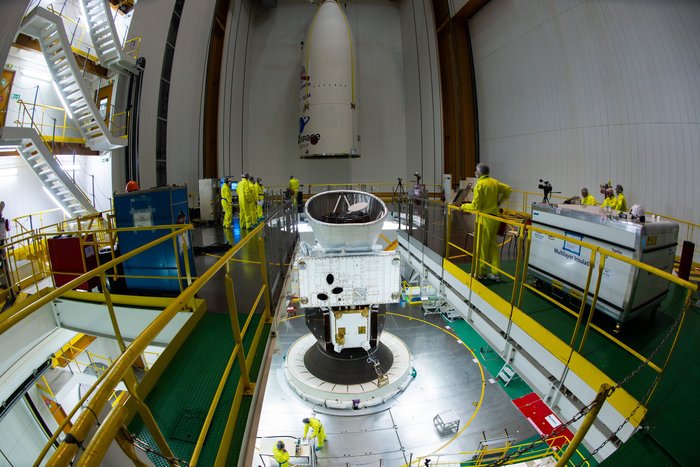
Scientific Equipments
To achieve all these diverse objectives, BepiColombo carries a total of sixteen scientific instruments: eleven on the MPO and five on the MMO. These instruments come from various locations in Europe as well as Japan for four of the five instruments aboard the MMO. Here are these instruments:
BELA: Pour BepiColombo Laser Altimeter, BELA est un altimètre laser. Il mesure avec une grande précision l’altitude d’un certain point sur la surface de Mercure afin de réaliser une carte topographique de la surface. BELA utilise un laser infrarouge d’une longueur d’onde de 1064nm et envoie des impulsions toutes les 0,1 secondes. 5 millisecondes après chaque émission, le rayon est reçu à nouveau par l’instrument grâce à un télescope de type Cassegrain (deux miroirs dont un percé en son centre et dont les axes optiques coïncident afin d’obtenir une image non pivotée) de 20cm de diamètre et d’ouverture f/5. Par rapport à la trace au sol de l’orbiteur, le faisceau laser est émis tous les 250m en latitude et chaque nouvelle orbite cause un décalage de 6km à l’équateur. Cet instrument a été fourni par l’Université de Berne en Suisse et l’Institut pour la recherche planétaire de la DLR, l’agence spatiale allemande, et est installé sur le MPO. Il pèse 12kg et consomme 36W d’électricité.
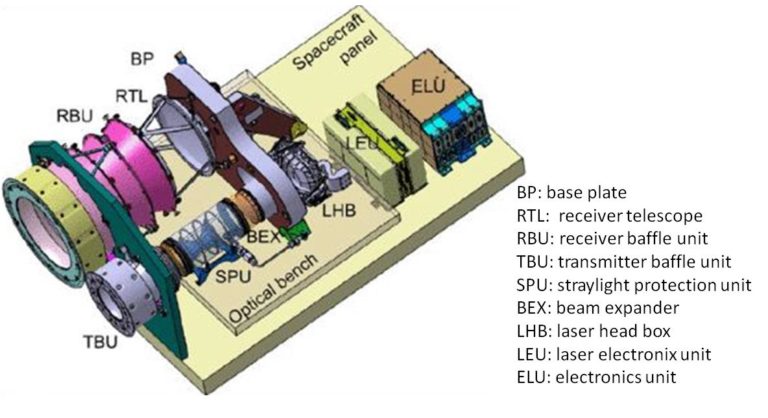
MPO-MAG: The MPO-MAG is part of the MERMAG (Mercury Magnetometer) magnetometer suite, which also includes the MMO-MGF on board the MMO. MPO-MAG is located at the end of a boom on the MPO. This instrument consists of two magnetometers positioned at different distances from the probe to measure the stray noise generated by electrical currents and magnets on board the orbiter. These two magnetometers have a sampling frequency of 128Hz, which can be reduced to 0.5Hz on command. They can measure a magnetic field over a variable range of ±2000nT (nanoTeslas, the unit representing magnetic flux density) with a resolution of 2pT. This instrument was developed by the Technical University of Brunswick in Germany.
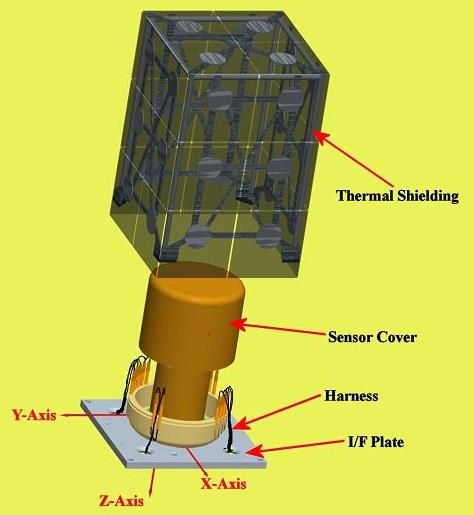
ISA: The instrument known as ISA, Italian Spring Accelerometer, is a 3-axis accelerometer designed to measure the forces applied to the probe by solar radiation in the visible spectrum and by the infrared radiation emitted by Mercury. Combined with various instruments for determining the orientation of the MPO, this accelerometer plays a crucial role in the proper functioning of the MORE instrument. ISA has a resolution of 10nm/s², weighs 5.8kg, and consumes between 7.4 and 12.1W of electricity. It was provided by the Institute of Astrophysics and Space Planetology of Rome (IAPS).
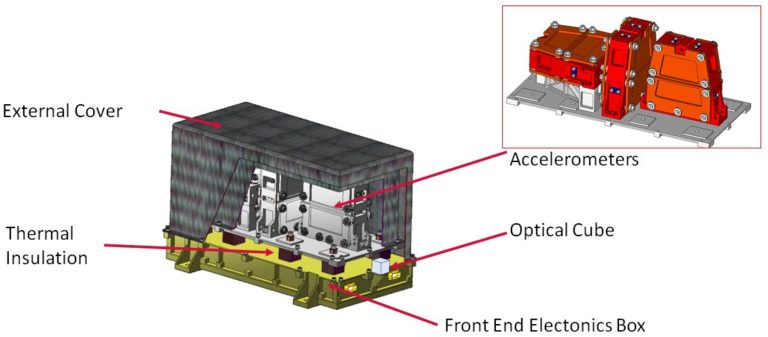
MORE: Mercury Orbiter Radio-science Experiment is a radio-science experiment carried out to measure Mercury’s gravity and deduce the size and physical state of the planet’s core. With this information, scientists worldwide can benefit from a very accurate model of Mercury and proceed with studies on the theory of gravity with unprecedented precision. MORE will also measure the precision of the MPO’s position determination system. MORE will use data from other instruments such as ISA, BELA, and SIMBIO-SYS to determine its position and orientation with the greatest certainty and finest resolution. To achieve these objectives, MORE will capture the signal emitted from Earth using a Ka-band antenna. By measuring the time it takes for the signal to arrive, it is possible to calculate the distance between the probe and the Earth segment with a precision of 15cm and a relative velocity with a resolution of 1.5µm/s for an integration time of 1000s. This instrument was developed by the University of Rome « La Sapienza ».
MERTIS : The infrared spectrometer (Mercury Radiometer and Thermal Infrared Spectrometer) will provide data on the geological composition of Mercury’s surface. To do this, it uses a spectrometer and a radiometer. The spectrometer will obtain the different wavelengths emitted by the planet’s thermal radiation over a wavelength range of 7 to 14µm. The radiometer, on the other hand, will provide measurements of the intensity of the electromagnetic radiation flux, i.e., the power of radiation received per solid angle. This second instrument can measure wavelengths over a range of 7 to 40µm. The two sensors forming MERTIS each have a spectral resolution of 9nm and a field of view of 4°. They are based on microbolometer technology to make their measurements: incident light heats a metal plate connected to a heat sink to cool it, and by measuring the temperature change of the plate, the power of the incident beam can be calculated and then traced back to its wavelength. MERTIS will establish a mineralogical map of 5 to 10% of the Mercurian surface with a spatial precision of 500m. It weighs 3.3kg, consumes 8 to 13W, and was provided by the University of Münster and the DLR. MERTIS is located on the MPO orbiter.
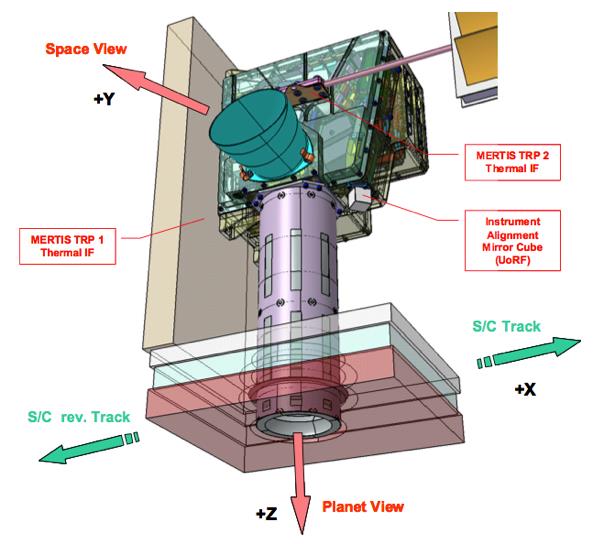
SERENA, which stands for Search for Exospheric Refilling and Emitted Natural Abundances, is an instrument composed of four detectors for neutral and ionized particles. The data collected will provide insights into the interactions between the magnetosphere/exosphere/surface and solar wind/interplanetary space. The first of the four detectors is ELENA (Emitted Low-Energy Neutral Atoms), which will measure the presence of neutral particles. It has a field of view of 4.5° by 76°, an angular resolution of 4.5° by 4.5°, and can detect particles with energies ranging from 20 to 5000eV. The second detector is STROFIO (Start from a Rotating Field mass spectrometer), a mass spectrometer that will determine the composition of gases present in Mercury’s exosphere. It analyzes neutral particles with energies below 1eV and has a field of view of 20° in the direction of the orbiter’s movement. The next detector is MIPA (Miniature Ion Precipitation Analyzer), which will study ions with energies ranging from 15 to 15,000eV that are precipitated towards the planet’s surface. Finally, the last detector of SERENA is PICAM (Planetary Ion Camera). This is another mass spectrometer that will analyze ions with energies from 1 to 3000eV projected from Mercury’s surface to its exosphere. SERENA was developed by the IAPS of Rome and is placed on the MPO.
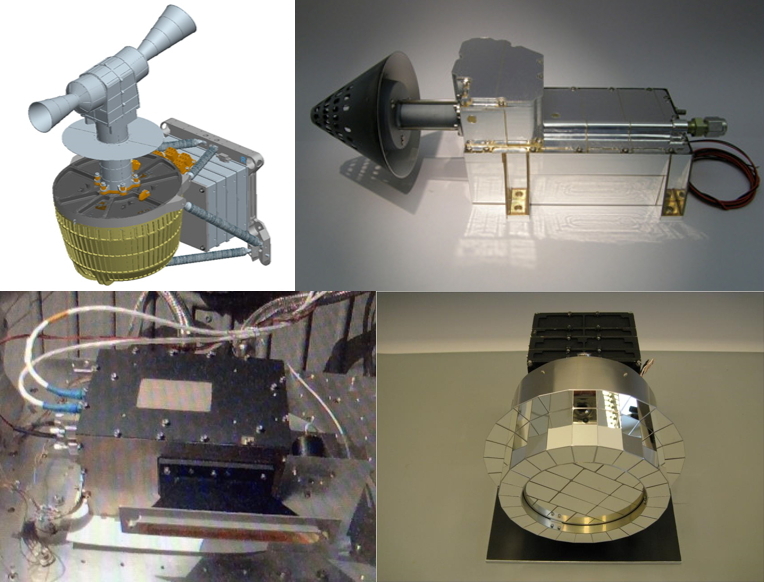
SIMBIO-SYS: The Spectrometer and Imagers for MPO BepiColombo Integrated Observatory System provides data on the geological activity, volcanism, tectonics, and age of Mercury’s surface. The instrument, developed by the Astronomical Observatory of Padua in Italy, is actually composed of three imagers: STC, HRIC, and VIHI. STC (Stereo Channel) is a camera equipped with two sensors to provide 3D images of the surface. Its spatial resolution is 50m per pixel, and its field of view is 4°. Images are captured in four wavelength bands to produce a panchromatic image: 550, (650), 700, and 880nm. STC will be used to map the topography of Mercury’s surface. HRIC (High spatial Resolution Imaging Channel) is a high-resolution spatial camera designed to obtain very precise images of preselected targets. Its field of view is only 1.47°, but its spatial resolution reaches 5m per pixel. HRIC captures images in the same wavelength bands as STC, and it has been announced that, by the end of the BepiColombo mission, more than 10% of Mercury’s surface will have been imaged by HRIC. The last imager of SIMBIO-SYS is the VIHI (Visible Infrared Hyperspectral Imaging Channel). This instrument operates in the visible and near-infrared spectrum (wavelengths from 400 to 2000nm) and has a spatial resolution of 100m with a spectral resolution of 6.25nm. VIHI will provide a mineralogical map of Mercury with a minimum resolution of 400m. All three instruments of SIMBIO-SYS are placed aboard the MPO.
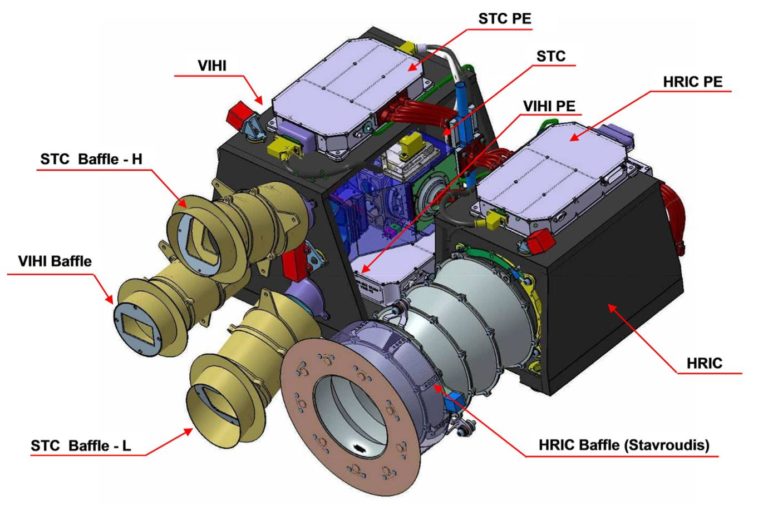
PHEBUS: Probing of Hermean Exosphere By Ultraviolet Spectroscopy is an ultraviolet spectroscope designed to study the radiation emitted by the exosphere by directly observing above the horizon of Mercury. This spectroscope contains an optical component composed of two sets of diffraction gratings and two sensors to cover a wide range of ultraviolet light. The incident radiation to be observed is reflected onto a deflector that can rotate 360° to change the instrument’s pointing direction, thus altering the location and altitude of observation. The first spectroscope allows observation of wavelengths in the range of 55 to 155nm, and the second covers a range of 145 to 315nm, as well as wavelengths 404 and 422nm. Their spectral resolution is 1nm, and the measurements provided will contribute to a better understanding of the interactions between the surface, exosphere, and magnetosphere. This instrument, located aboard the MPO, was provided by the French Laboratoire Atmosphères, Milieux, Observations Spatiales (LATMOS) and the Space Research Institute of the Russian Academy of Sciences (IKI RAN).
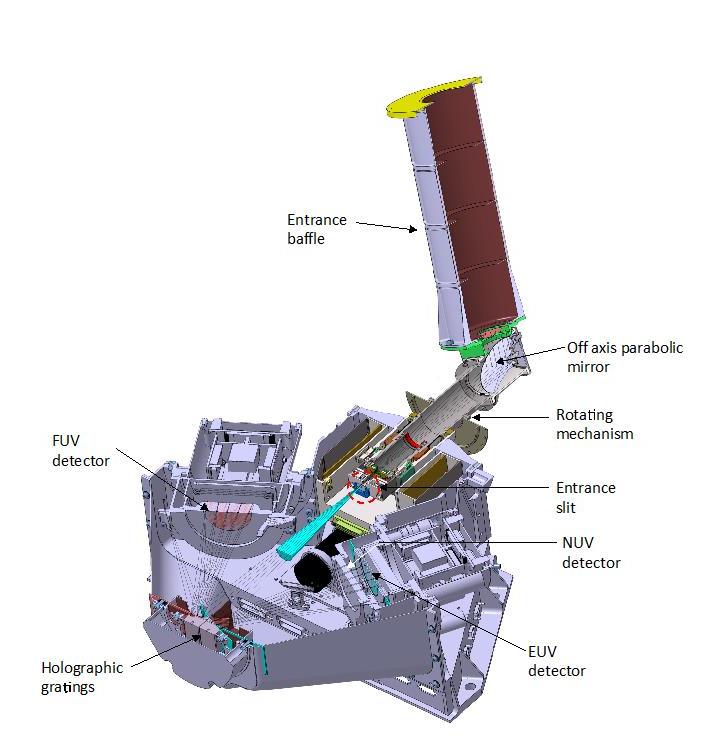
MIXS: The Mercuring Imaging X-ray Spectrometer (MIXS) is an ultraviolet spectrometer that exploits the phenomenon of X-ray fluorescence to determine the chemical composition of Mercury’s surface. This phenomenon can be explained as follows: When X-rays from solar radiation reach the planet’s surface, some electrons from the K and L electron layers will become excited. Upon de-excitation, they emit an ultraviolet photon characteristic of the chemical element hosting the electron. Thus, MIXS, with its two sensors, MIXS-T (high resolution but with a reduced field of view of 1°) and MIXS-C (with a 10° field of view but lower resolution), will capture the fluorescence-emitted photons over an energy range of 0.5 to 7.5keV, corresponding to wavelengths from 248nm to 16.5nm. With this data, MIXS can then determine the abundance of different light atoms in rocks such as magnesium, aluminum, iron, titanium, and silicon. The precision of this instrument ranges from 5 to 50% depending on the abundance of the elements. This instrument is provided by the University of Leicester in the United Kingdom and is placed aboard the MPO.
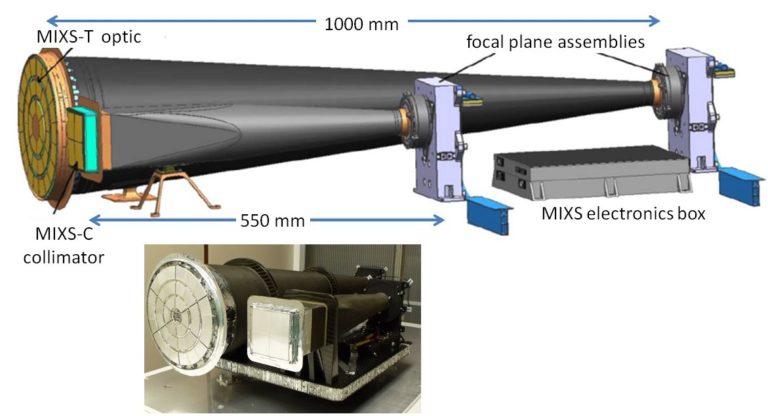
SIXS: The Solar Intensity X-ray and Particles Spectrometer (SIXS) is an instrument consisting of two sensors that will measure in situ the spectrum of X-ray radiation over an energy range from 1 to 20keV, as well as protons over a range of 0.33 to 30MeV, and electrons ranging from 50 to 3000keV. This instrument can measure up to 20,000 particles and photons per second thanks to its wide 180° field of view. The objective of SIXS is to measure the flux of radiation from the Sun as well as that reflected by Mercury. SIXS was developed by the University of Helsinki in Finland. Additionally, this instrument will calibrate MIXS. Interestingly, the names MIXS and SIXS are not just acronyms; they also carry meaning in Finnish, with MIXS representing “why?” and SIXS representing “that’s why!”
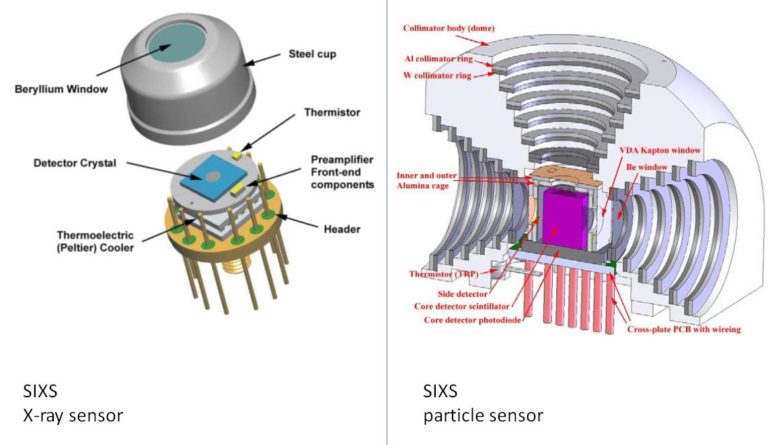
MGNS: The Mercury Gamma-ray and Neutron Spectrometer (MGNS) aims, firstly, to refine and verify the chemical composition of the entire surface of Mercury with a precision of 0 to 30% and a spatial resolution of 400km. A second objective of MGNS is to provide the distribution of volatile elements that may have accumulated in the polar craters, perpetually shaded. Thus, the spectrometer will provide a map of the spatial density of these deposits with a precision of 0.1g/cm² and a spatial resolution of 400km. It will also confirm or refute the presence of water ice at the poles. To accomplish these measurements, MGNS relies on the interaction between the atoms of the surface layers of the soil (up to 2m deep) with neutrons from cosmic rays. Excited atoms will then emit gamma rays characteristic of the atom in question. Moreover, MGNS can detect traces of potassium, thorium, and uranium, which naturally produce gamma rays. This instrument consists of five detectors: MGRS (Mercury Gamma-Ray Spectrometer), a gamma-ray spectrometer that uses a lanthanum bromide (LaBr3) scintillator to produce light more easily exploitable from ionizing gamma rays, and MNS (Mercury Neutron Spectrometer), consisting of four neutron detectors using helium-3 gas proportional counters. These detectors can accurately measure a small amount of ionizing radiation by measuring an electric current generated by this radiation in a chamber filled with helium-3 through the ionization of this chemical element. This instrument was provided by IKI RAN in Moscow and placed aboard the MPO. It weighs 5.5kg and consumes 6.5W of electricity.
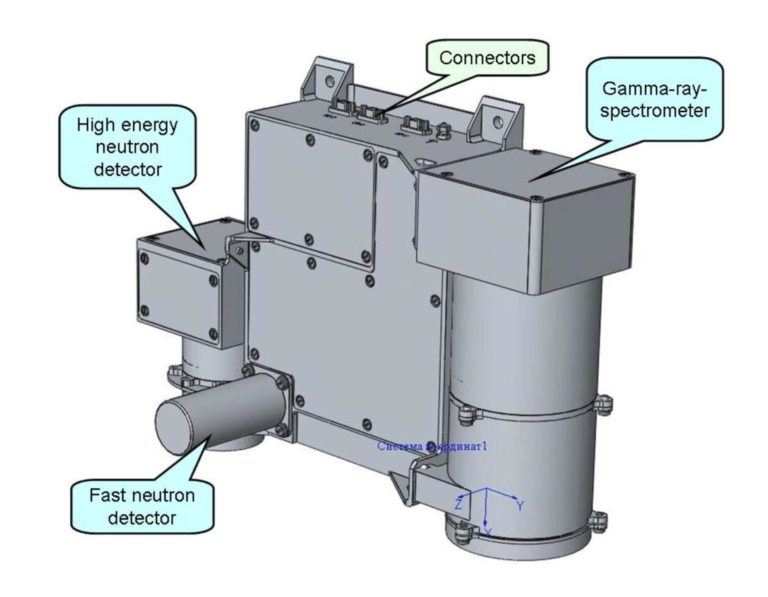
MMO-MGF: The MMO Magnetometer Fluxgate instrument comprises two triaxial magnetometers: MGF-O (outboard), located at the end of a 4.4m mast named MAST-MGF, and MGF-I (inboard), situated 1.6m from the end of the same mast. Similar to MPO-MAG, these two magnetometers will help isolate the noise generated by the probe’s systems. Both magnetometers can measure magnetic flux over a dynamic range of ± 2000nT with a resolution of 3.8pT and a sampling frequency of 128Hz. This instrument complements the magnetometer carried aboard the MPO: MPO-MAG. MMO-MGF was provided by the Space Research Institute of Graz in Austria.
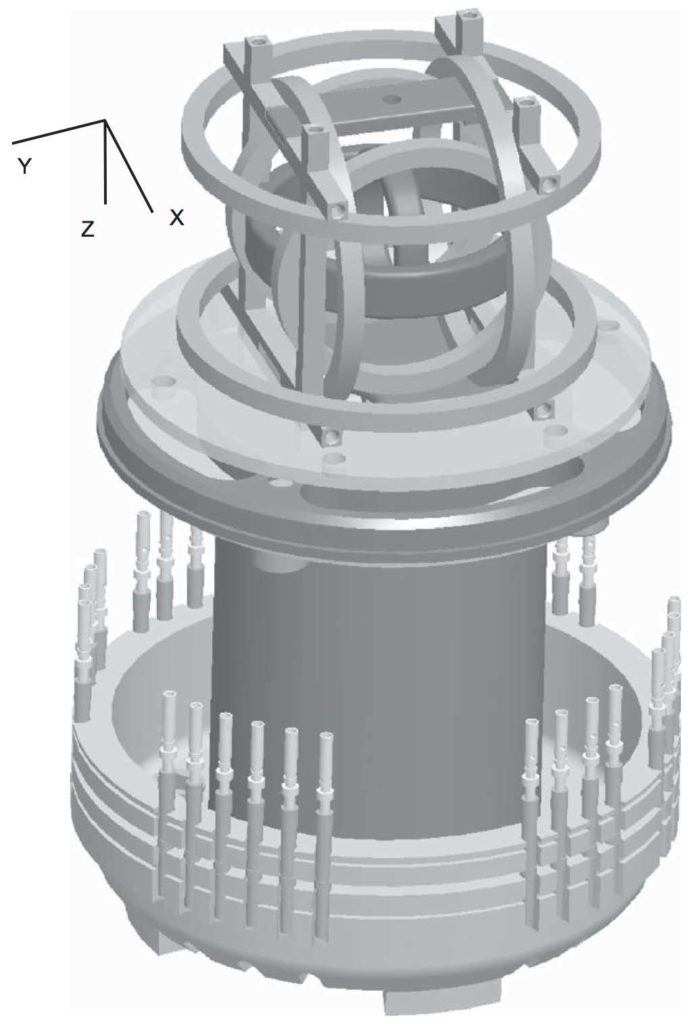
MPPE: The Mercury Plasma and Particle Experiment is a detector of plasma, high-energy particles, and energetic neutral atoms. It will study the interactions between the solar wind and Mercury’s magnetosphere. To achieve this, MPPE consists of seven detectors: MEA 1 and 2 (Mercury Electron Analyzers) mounted at 90° to each other, which study electrons, similar to HEP-electron (High Energy Particle instrument for electron). The detectors MIA (Mercury Ion Analyzer), MSA (Mercury mass Spectrum Analyzer), and HEP-ion (High Energy Particle instrument for ion) are responsible for studying ions. Finally, the ENA sensor (Energetic Neutrals Analyzer) detects and measures the energetic neutral particles produced during the fusion between ions and electrons. The MPPE instrument was provided by ISAS located in Kanagawa, Japan, and is now aboard the MMO.
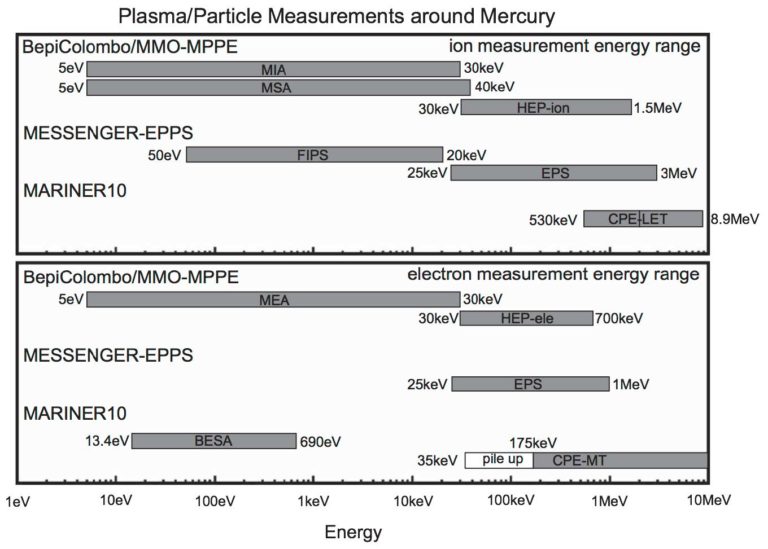
MDM: The Mercury Dust Monitor is a dust detector that quantifies and studies dust particles to obtain information about their characteristics at the orbit of Mercury. With four detectors, MDM measures the impact energy, approximate direction, and density of these dust particles in interplanetary space. Each of these detectors is a piezoelectric sensor made of ceramic PZT (Lead Titanate-Zirconate) measuring 40mm by 40mm. When a certain pressure is applied to these sensors (in this case, when dust particles hit them), the ceramic produces a slight voltage between its two faces, which depends on the applied pressure. The sensitivity of these sensors is 1pg.km/s (meaning that to be detected, the dust must have a momentum p=mv greater than 1pg.km/s). MDM can study almost an entire hemisphere, and it is estimated that 100 to 200 impacts per year (on Earth) will be recorded. This instrument, placed on the MMO, was provided by the Chiba University of Technology in Japan. In total, this instrument weighs 601g and consumes a maximum of 3W.
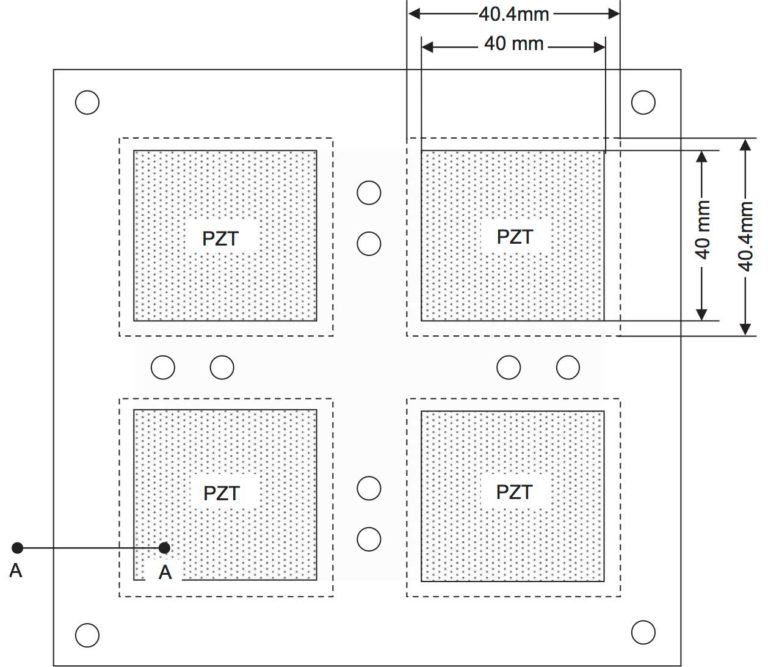
MSASI: The Mercury Sodium Atmospheric Spectral Imager is a spectrometer designed to measure very specifically the D2 line of the sodium emission spectrum (589nm ± 0.028) on the surface of Mercury. This line exhibits an abnormal and still unexplained distribution. To conduct its measurements, MSASI is equipped with a Fabry-Perot interferometer provided by the University of Tokyo in Japan and a rotating mirror to cover the entire surface of the planet. This device has a spectral resolution of 0.009nm and a spatial resolution of 3 to 30km. It weighs 3.48kg and consumes 15.2W of electricity.
PWI: The Plasma Wave Investigation (PWI) instrument consists of two types of electric field detectors (MEFISTO and WPT) and two magnetic field detectors (LF-SC and DB-SC) that measure the shape of waves and the frequency of the electric field up to 10MHz and the magnetic field from 0.1Hz to 640kHz. The MEFISTO (Mercury Electric Field In Situ Tool) and WPT (Wire Probe Antenna) devices are two 32m antennas deployed on either side of the MMO orbiter (16m on one side and 16m on the other) at a 90° angle to each other. The LF-SC (Low-Frequency Search Coils) and DB-SC (Dual-Band Search Coils) sensors are placed at the end of the 4.4m mast, MAST-SC, located opposite to the MAST-MGF where the MMO-MGF magnetometers are located. This instrument was developed and provided by Tohoku University in Japan.
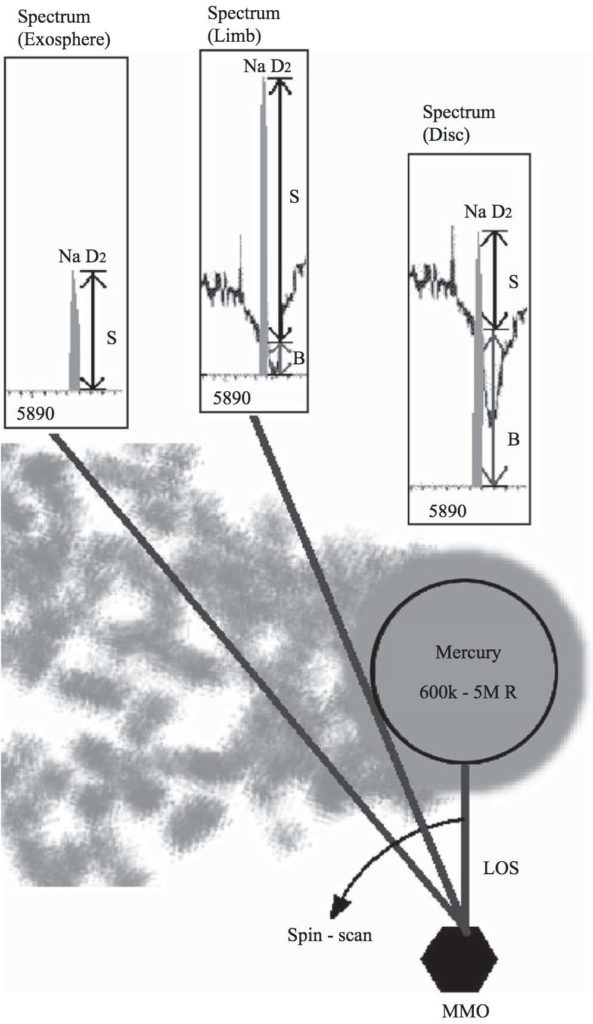
Technical specifications of BepiColombo
BepiColombo consists of four distinct parts: two probes, a transfer stage, and a protective shroud.
MPO
The first and largest of the probes is the MPO, which stands for Mercury Planetary Orbiter. This probe was developed by ESA and will be placed in an elliptical polar orbit around Mercury. Its apoapsis will be at 1500km and its periapsis at 480km, allowing it to complete one revolution in 2 hours and 21 minutes. The mass of this orbiter is 1230kg, including 669kg of liquid propellant and 85kg of payload. The payload consists of eleven experiments carried by the MPO: BELA, MPO-MAG, ISA, MORE, MERTIS, SERENA, SIMBIO-SYS, PHEBUS, MIXS, SIXS, and MGNS. All these instruments will produce a data volume of 1550 gigabits per year. The probe measures 2.4m wide, 2.2m deep, and 1.7m high. It has a 7.5m long solar panel composed of three panels, with a total surface area of 8m², producing an average power of 1800W. To limit the temperature of this panel to 215°C, it has been covered with optical solar reflectors and oriented to never face the solar rays.
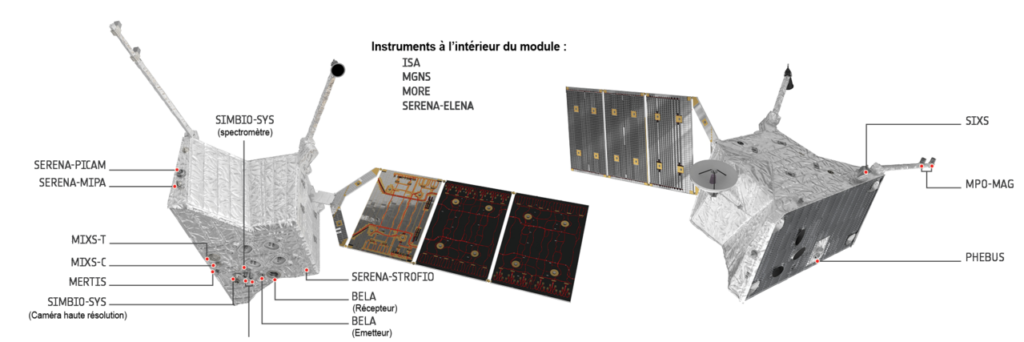
The MPO is equipped with an attitude control system consisting of four reaction wheels and two redundant sets of four rocket engines with a thrust of 10N. To determine the orbiter’s orientation, it is equipped with three star trackers, two solar sensors (similar to star trackers but using the sun for orientation), and two inertial measurement units, each equipped with four accelerometers and four gyroscopes. Trajectory corrections are carried out by two redundant sets of four rocket engines, each with a thrust of 22N. All of the MPO’s thrusters use a mixture of hydrazine and MON-3 (a mixture of 97% nitrogen tetroxide and 3% nitric oxide).
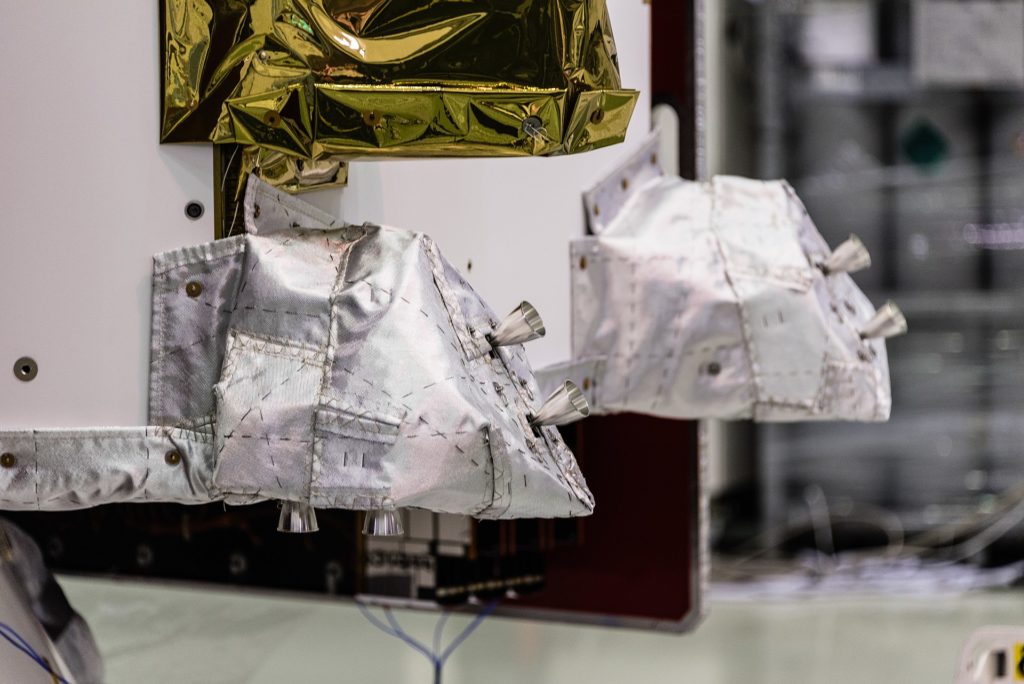
Communication with the MPO is ensured by a steerable high-gain antenna in X and Ka bands, with a diameter of 1 meter. This antenna is deployed shortly after launch to ensure the most powerful communication possible. However, the orbiter also has a steerable medium-gain antenna and two fixed low-gain antennas.
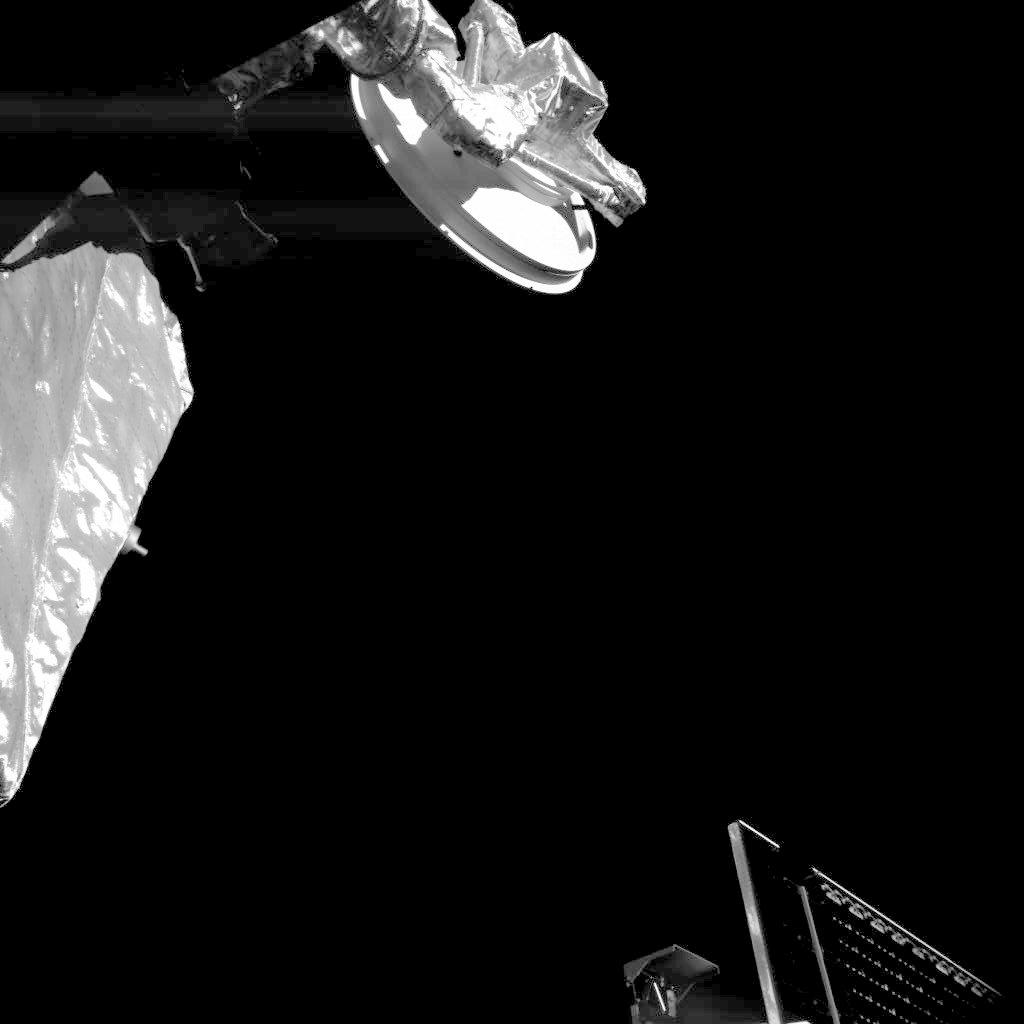
The MPO probe will be subjected to particularly intense thermal conditions. Indeed, at 0.3 AU from the Sun, the radiation heats the orbiter’s surfaces to over 400°C due to a thermal flux 10 times higher than in Earth orbit. In addition to this, there is the infrared radiation from Mercury, which is 20 times more intense than what a satellite in low Earth orbit would experience. To cope with this issue, the body of the MPO is covered with three layers of thermal insulation. The outer layer, manufactured by Airbus, is a stack of nearly 50 thin sheets of ceramic and aluminum, making the material resistant without degradation to temperatures up to 450°C. The intermediate layer is less resistant, withstanding temperatures up to 250°C. Finally, the inner layer is a standard thermal protection layer. The three layers of protection are spaced 2 cm apart from each other to absorb the impact of any potential micrometeorites.
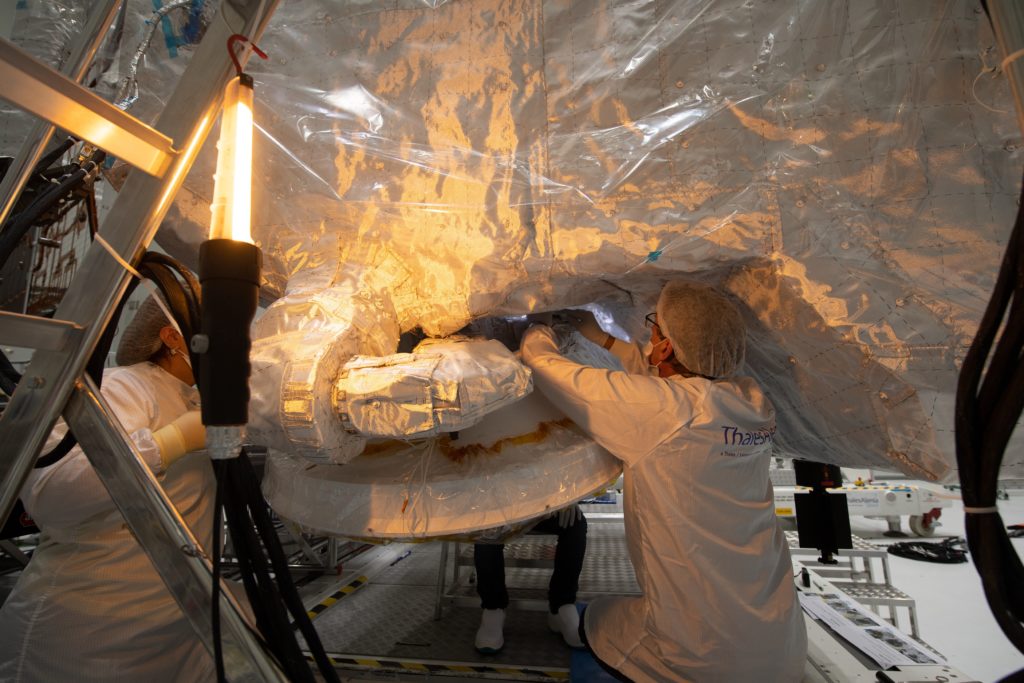
However, in order to dissipate the 300W of incoming heat and the 1200W generated by the electronics, one side of the MPO has been transformed into a radiator. A network of 97 tubes serves as conduits for the heat to then be expelled by the radiator made of titanium coated with silver. This side never faces the Sun but may be exposed to the infrared radiation from Mercury. The fins are therefore arranged in such a way that the radiation emitted by the planet is reflected to prevent heating of the probe.
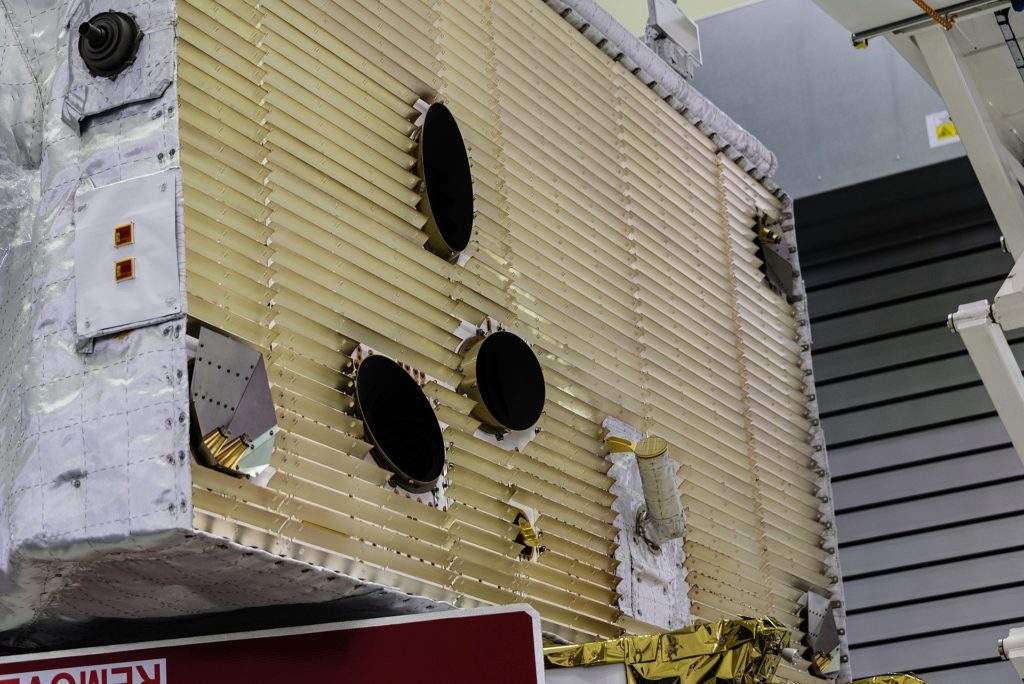
MMO
The small orbiter MMO (Mercury Magnetospheric Orbiter), renamed Mio which means “navigable waterway” in Japanese, representing the journey of the project, was developed by JAXA, the Japanese space agency, to study Mercury’s magnetosphere. For this purpose, the MMO is equipped with five scientific instruments, which account for 40kg of the probe’s mass: MMO-MGF, MPPE, MDM, MSASI, and PWI. They will produce a total of 100 gigabits of data per year. This orbiter will be placed in a highly elliptical polar orbit with an apoapsis at 11640km and a periapsis at 590km. Thus, the MMO will complete an orbit in 9 hours and 17 minutes. It has the shape of an octagonal prism with a height of 0.9m and a diameter of 1.8m. It weighs a total of 275kg and has only a small amount of cold gas for attitude control. Therefore, it will be rotated at 15 revolutions per minute about an axis parallel to Mercury’s rotation axis. This ensures that the two ends of the prism are never exposed to the Sun.
Data from the MMO are transmitted by a high-gain antenna located on the top face. This 80cm diameter parabolic antenna transmits data in the X band at a rate of 16 kilobits per second, or approximately 350 megabits per 6-hour session per day. The probe has an internal memory of 2GB (16 gigabits) to store telemetry and scientific data between radio sessions. The MMO also has a smaller fixed medium-gain antenna. The upper part of the orbiter’s octagonal walls is covered with solar panels and mirrors to limit heat, similar to the MPO. These produce 350W of electrical power to supply all internal systems, including the 53W required by the scientific instruments.
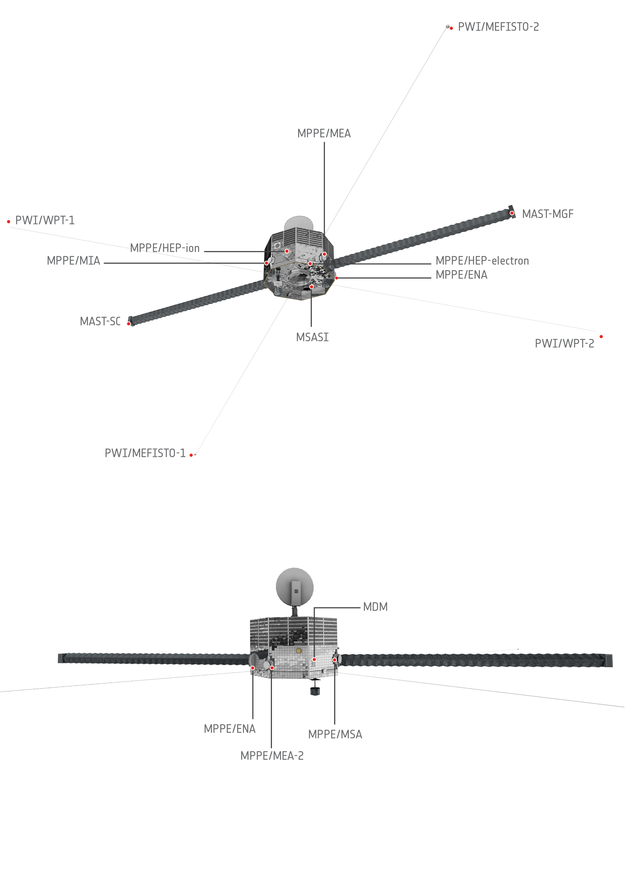
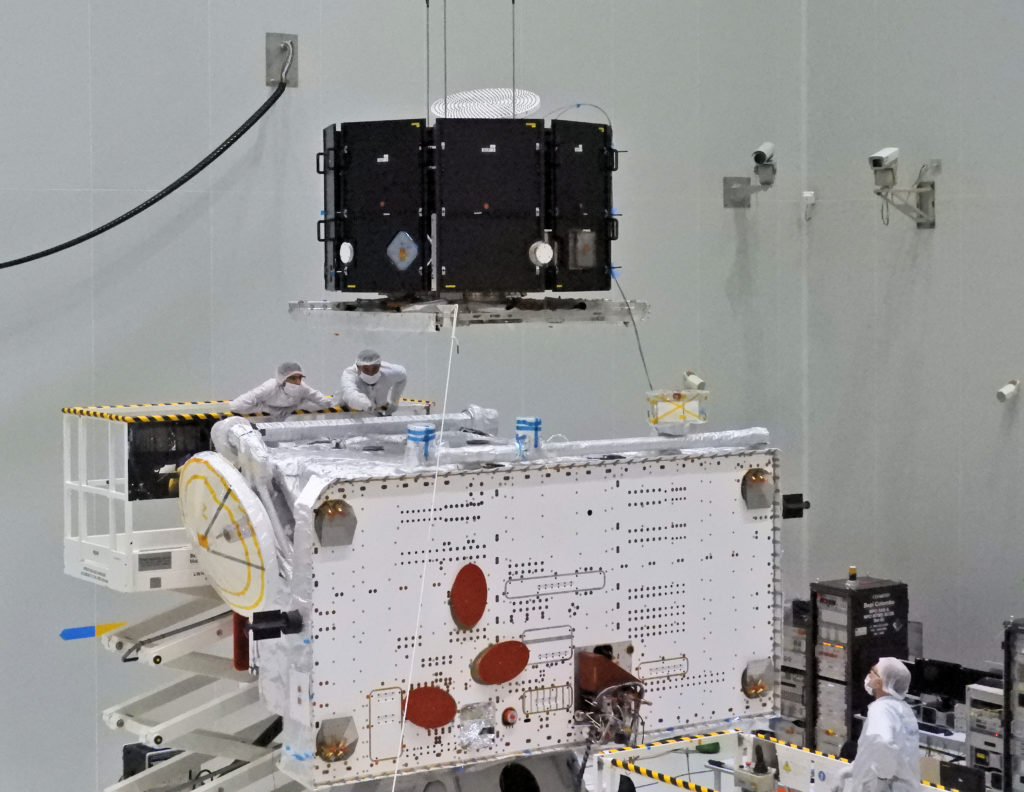
MOSIF
Throughout the entire journey to Mercury, the MMO orbiter is protected by a sunshield skirt that also serves as an interface between the Japanese probe and the European probe: the MOSIF, Magnetospheric Orbiter Sunshield and Interface Structure. This skirt measures 3m in diameter and 1.8m in height, weighing 145kg, including 20kg for the MMO ejection and rotation system. Its thermal protection is extremely similar to that of the MPO.
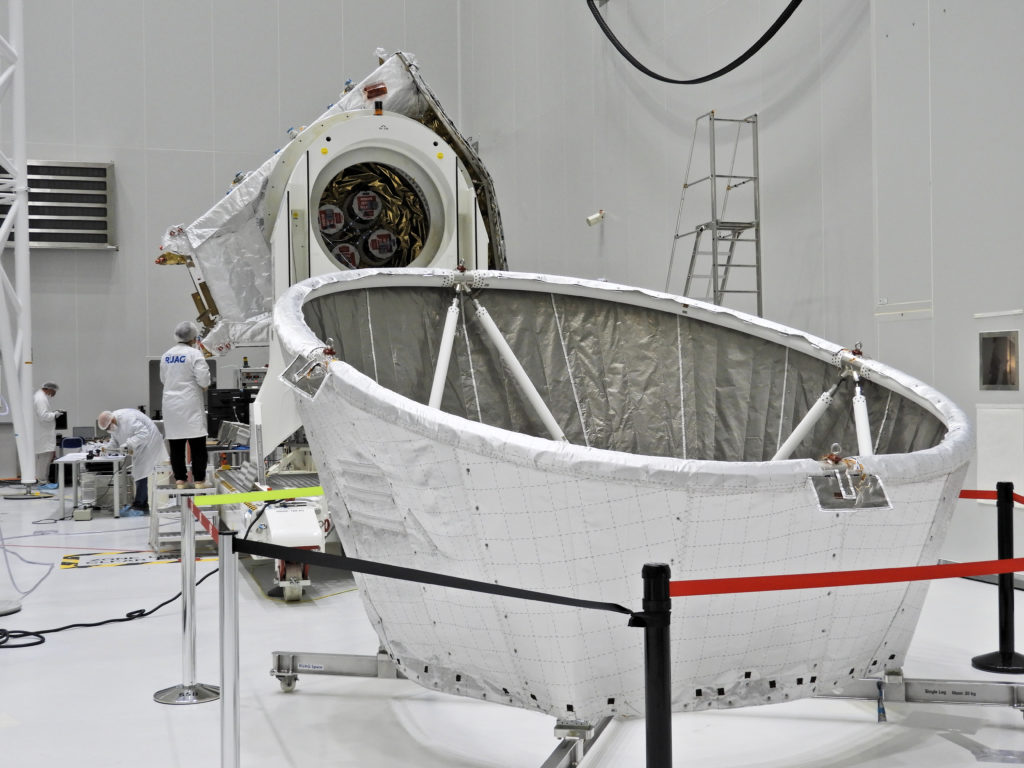
MTM
In order to transport the two probes to Mercury, BepiColombo utilizes a transfer stage: the MTM for Mercury Transfer Module. The MTM weighs 2645kg, including 587kg of xenon (approximately 10% of the world’s annual production) and 157kg of chemical propellants. It measures 3.7m wide, 3.5m deep, and 2.3m tall, making it the most voluminous component of the mission. In addition to its significant volume, two enormous solar panels measuring 14m each in length are attached. They can generate approximately 13kW of electricity. Almost all of this power is used for one purpose: the electric propulsion system, MEPS.
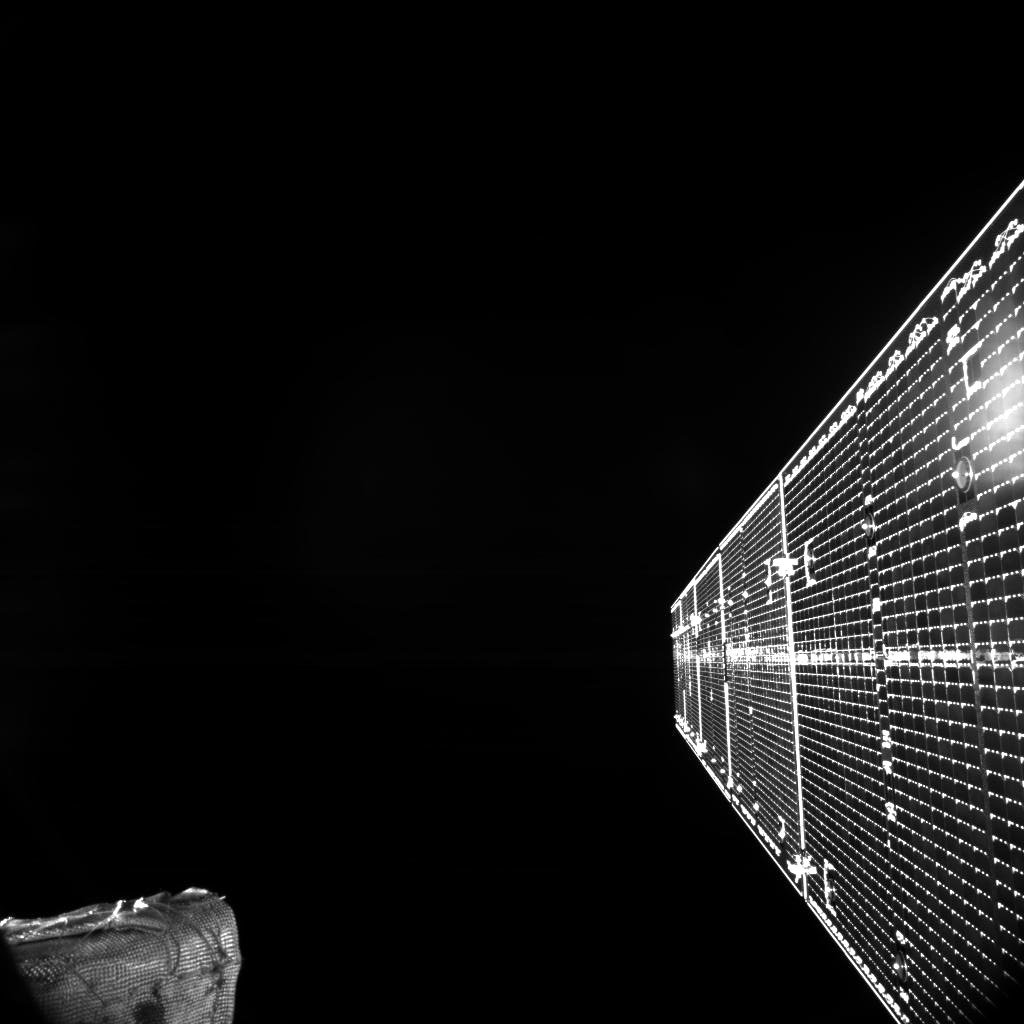
The MEPS (MTM Electric Propulsion System) consists of four ion thrusters. The way these thrusters work is quite simple: Xenon is injected into the thruster chamber where it is ionized before the atom nuclei are accelerated by large electromagnets. This system is extremely practical due to its unmatched efficiency: The specific impulse (which measures the efficiency of a thruster) of the MEPS thrusters ranges from 3958 to 4285 seconds, compared to only 453 seconds for the RS-25 cryogenic engine, currently the most efficient liquid-fuel engine. However, these thrusters only produce a unitary thrust of 145mN (compared to 2279kN for the RS-25). By varying the electrical power, the thrust can be modulated: Thus, a power of 2.5kW will provide 75mN of thrust, and 4.6kW will provide 145mN.
Thanks to the 587kg of xenon carried by the MTM, the latter will have a delta-V of 5,400m/s. Each of these four thrusters can be precisely oriented to steer BepiColombo as desired. In the normal operation mode of the MTM, only two out of the four ion thrusters are used at the same time. Throughout the mission, the MEPS must operate for 880 days spread over more than 25 propulsion phases, with the longest lasting 167 days. 30 days before each planetary flyby, the MEPS is deactivated to avoid disturbing the gravitational assist. The four thrusters of this system are provided by QinetiQ, the British manufacturer that had previously supplied those for the European satellite GOCE.
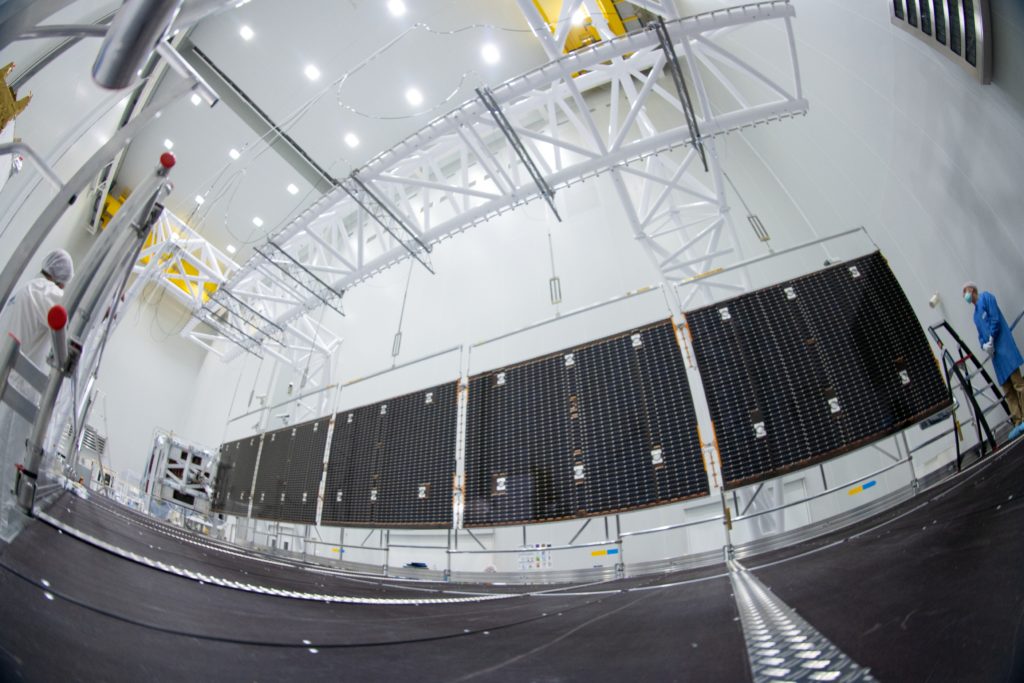
The solar panels of the MTM can be directly pointed towards the Sun when the distance between them is less than 0.62 AU. Below this distance, the solar radiation becomes too intense, causing the solar panels to reach temperatures that degrade them. To address this issue, they are gradually tilted to limit the surface in direct contact with the radiation. However, to maintain the power required for the proper operation of the MEPS, these panels had to be enlarged, hence their surface area of 45m².
To learn more about the mission’s timeline, whether it’s about its development or progress, all you have to do is read this second article on the past and future history of BepiColombo.
If you want to see plenty of beautiful images of the mission, whether it’s from the launch, its manufacturing, or even later, those captured by the probes, go check out the ESA’s gallery.



